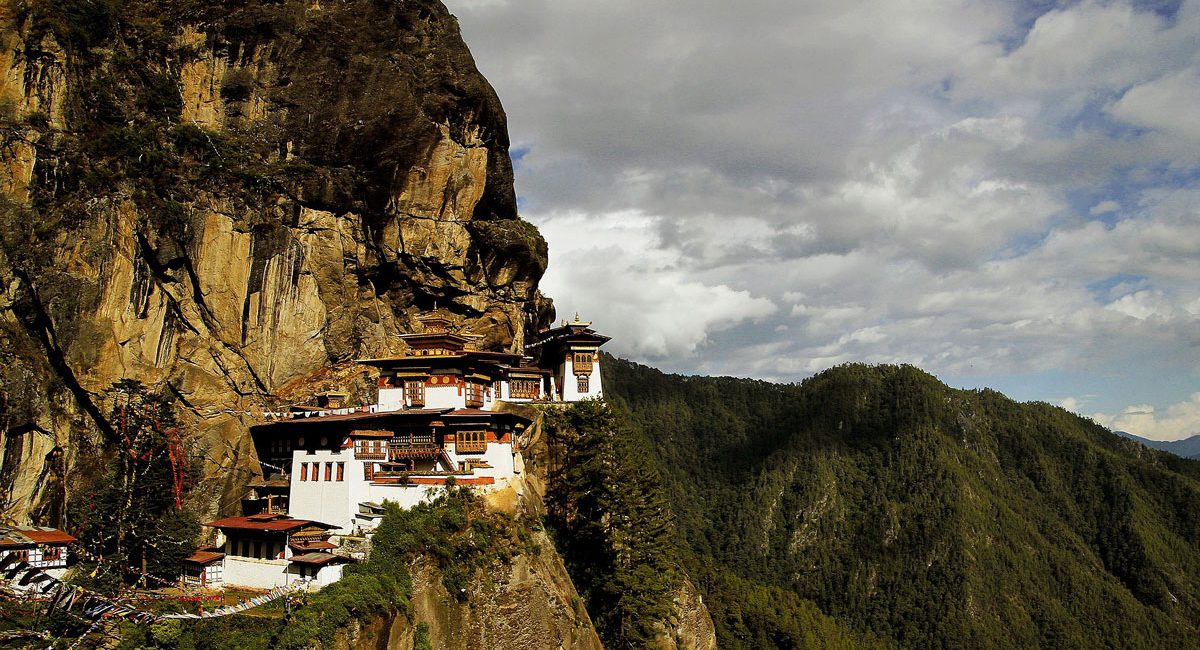Visit Taktsang Monastery: Bhutan’s Most Iconic Monastery That’s Impossibly Perched On A Sheer Cliff
Globe Aware volunteers who wish to visit Buddhist temples like the majestic Takhsang must obtain a “temple permit.” If you are interested in exploring temples on your future volunteer vacation to Bhutan, feel free to contact our office and we’ll help you plan accordingly!
Visit Taktsang Monastery: Bhutan’s Most Iconic Monastery That’s Impossibly Perched On A Sheer Cliff
This important pilgrimage site is one of the most popular tourist destinations in Bhutan and judging by its architecture, it’s pretty easy to see why.
BY AARON SPRAY
OCT 31, 2021
The Paro Taktsang, or Taktsang Palphug Monastery – also known in English as the “Tiger’s Nest” or “Tiger’s Lair” is one of the most iconic and mind-bending Buddhist monasteries in the world. It is a sacred Vajrayana Himalayan Buddhist site and is located on the cliffside of the upper Paro valley in Bhutan.
It is one of the thirteen Tiger’s Nest caves in historical Tibet as one of the thirteen “Taktsang” or “tiger lair” caves. It is one of the most sacred and important sites in the Kingdom of Bhutan. Those who wish to see the wonders of modern-day Tibet in China can if they book with a tour company.
History And Legend Of The Tiger’s Lair
The story of Takstang comes from 747 AD when Guru Padmasambhava chose the cave in the sheer rock face to meditate. The legend goes that he flew to the site on the back of a tigress and meditated in the caves for 3 years, 3 months, 3 days, and 3 hours so that he could subdue evil demons that lived in it. Since then the cave has been considered sacred and has become an important pilgrimage site.
- Built: Around 1692 (Buildings Around The Cave)
The elegant structure that inspires people today was built around the cave in 1692 and has become a cultural icon of Bhutan. It is one of the most venerated pilgrimage destinations in the Himalayas and it clings to the rock towering over 800 meters over 2,600 feet above the valley. It takes around 2 to 3 hours to reach by climbing if coming from the nearby town.
The Monastery Today
The shrine is dedicated to Padmasambhava or the “Shrine of the Guru with Eight Names” referring to Padmasambhava’s eight manifestations.
- Height: 800 Meters or 2,600 Feet Above the Valley Floor
- Altitude: 3,120 Meters or 9,678 Feet Above Sea Level
- Time To Climb: 2 to 3 Hours Depending on Fitness Level (12 Km or 8 Miles From the Paro Town)
Today the monastery is one of the most famous and touristic destinations in Bhutan. Visiting this monastery is certainly an unforgettable experience. It is notable for its isolation and is only accessible by mountainous paths. The mountainous Paro valley lies in the heart of Bhutan. The Paro valley hosts the only international airport in the country.
While its isolation makes it special and romantic, it also creates other headaches. In 1998 a fire broke out in the main building of the complex (which also contained valuable paintings, statutes, and artifacts). And it was burned down completely with emergency services unable to provide assistance. The monastery was subsequently restored.
- Destroyed: In 1998 By A Fire
The complex is made up of white buildings with golden roofs. The monastery complex consisted of 4 main temples and several dwellings. All the buildings are interconnected with staircases with steps carved into the rock and most of the buildings have a balcony with breathtaking views of the surrounding area. There are eight caves in the monastery, of which four are easier to access.
- Rotation: Every Morning At 4.00 am The Prayer Wheel is Rotated By Monks To Mark A New Day
There are golden idols everywhere and in the hall of Thousand Buddhas (which is carved into the rock) is a large statue of a tiger.
Visiting Bhutan
The Kingdom of Bhutan follows a policy of “High Value, Low Impact Tourism” and so tourism in the kingdom is highly regulated. Only a limited number of tourists are permitted to enter the country at any one time in an effort to preserve the unique qualities of the all Himalayan country.
- Policy: “High Value, Low Impact Tourism”
While tourists are issued a 7 or 14-day “entry permit” they are only able to enter the area around Thimphu and Paro and the rest of the country is considered a restricted area. There are immigration checkpoints throughout the country.
- Visiting Temples: Requires A Temple Permit
Foreigners who wish to visit Buddhist temples like Takhsang must obtain a “temple permit” from the Ministry of Culture. The permits are normally arranged by tour operators.
- Spending: One Must Spend A Minimum of $250 or $200 A Day Depending On The Season
With the exception of Indian, Bangladeshi, and Maldives citizens, all foreigners must apply for a visa before visiting Bhutan. Foreign tourists must have a licensed Bhutanese tour operator who must pre-arrange their holiday. Every tourist must spend a minimum of around $250 a day during the tourist high season or $200 a day for the low season.
While in the region, visit the eye-watering Himalaya country of Nepal and see their seven UNSECO Listed world heritage sites. This is a stunning region where India meets Tibet and is a region that has inspired people for generations.


0 Comments